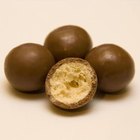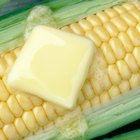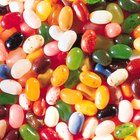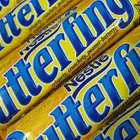
Creatas/Creatas/Getty Images
At home, at the theater, as a snack or a dessert, the peppermint candy Junior Mints has become a favorite all over the world. For more than 50 years, the rattle of the candy box has been heard in the hands of kids and adults alike. Today, more than 15 million Junior Mint candies are produced daily and shipped out all over the world.
History of Junior Mints
Junior Mints are manufactured by Tootsie Roll Industries and first made their appearance in 1949, when they were named after the popular Broadway show Junior Miss. The original candy was and still remains a cool peppermint inside covered by a hard shell of dark chocolate.
Toosie Roll Industries Candy and Healthy Living
Tootsie Roll Industries remains committed to health living. Many of the Tootsie Roll products remain under 100 calories per serving and are either low-fat or fat free. All products are gluten-free, peanut-free and nut-product free. While corn and soy are used in Tootsie Roll products, none of the products include wheat, barley, rye, oats, triticale, spelt or any of their components, either as ingredients or as part of the manufacturing process. And Tootsie Roll Industries does have four kosher certified products: Tootsie Rolls, Tootsie Fruit Rolls, Frooties, and DOTS.
Ingredients in Junior Mints
As listed on the nutrition label, Junior Mints contain: sugar, semi-sweet chocolate, corn syrup, confectioner's glaze, modified food starch, peppermint oil, the enzyme invertase, the protein soya albumin and gelatin. The semi-sweet chocolate is made of sugar, chocolate, cocoa butter, the emulsifier soya lecithin and the artificial flavor vanillin. The manufacturer warns that milk and egg may be present.
Nutrition Information for Junior Mints
A serving of junior mints is 40 g. Each serving has 170 calories, 3 g total fat or 5 percent recommended daily value, 2.5 g saturated fat or 13 percent DV, 30 mg of sodium or 1 percent DV, 35 g of carbohydrates or 12 percent DV, 1 g of dietary fiber or 4 percent DV, 32 g of sugars, and 1 g of protein or 2 percent DV.
Vitamins and Minerals in Junior Mints
Junior Mints are not a significant source of vitamin A or C or calcium. As per the nutrition label they contain zero percent of the recommended daily values. They do however contain 8 percent of the DV of iron. The percent daily values are based on a 2,000 calorie diet, which may be higher or lower depending on your gender, activity level and needs.
Related Articles

Nutrition Facts for Tootsie Rolls

Premium Saltine Crackers Nutrition

Malted Milk Ball History

Rolo Nutrition Information

The Ingredients in Jergens Naturals

How Much Caffeine Is in Tootsie Rolls?

How Many Calories Do Popular Chocolates ...

Nutrition Information for Nabisco Teddy ...

Fiber Sure by Metamucil Ingredients

Calories in a Small York Peppermint ...

Common Food Emulsifiers

Aveda Shampure Ingredients

Calories in Chocolate Covered Pretzels

The Ingredients in Clif Bars

Keebler Club Crackers Nutrition ...

What Are the Ingredients in Elizabeth ...

How Many Calories Are in Peanut M&Ms?

Does Cream of Tartar Contain Dairy?

Jelly Belly Nutritional Information

Butterfinger Candy Bar Facts
References
Writer Bio
Cristina Gonzalez has been professionally writing since 2001, from college newspapers to national print publications. Her work has appeared in "Popular Mechanics," "Redbook," "Everday with Rachael Ray," "POZ" and "Real Health." Gonzalez has a Bachelor of Arts in magazine journalism from the University of Florida and a Master of Arts in magazine journalism from New York University.
Photo Credits
Creatas/Creatas/Getty Images